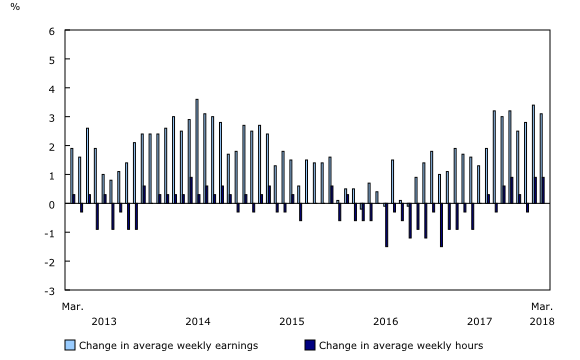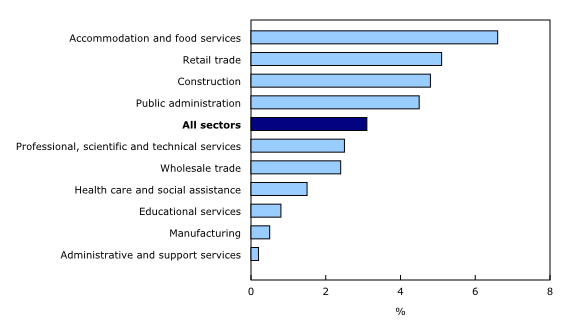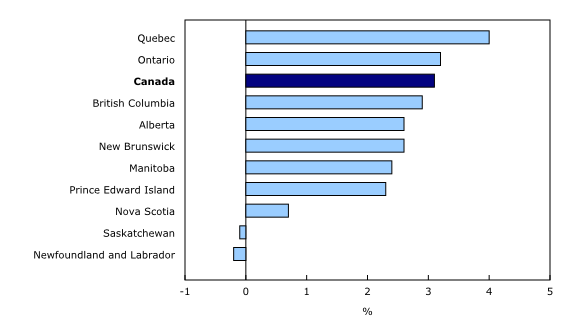Payroll employment, earnings and hours, March 2018
Archived Content
Information identified as archived is provided for reference, research or recordkeeping purposes. It is not subject to the Government of Canada Web Standards and has not been altered or updated since it was archived. Please "contact us" to request a format other than those available.
Released: 2018-05-31
$997.34
March 2018
3.1% 
(12-month change)
$1,036.80
March 2018
-0.2% 
(12-month change)
$840.36
March 2018
2.3% 
(12-month change)
$872.35
March 2018
0.7% 
(12-month change)
$903.94
March 2018
2.6% 
(12-month change)
$930.82
March 2018
4.0% 
(12-month change)
$1,013.67
March 2018
3.2% 
(12-month change)
$931.47
March 2018
2.4% 
(12-month change)
$1,015.37
March 2018
-0.1% 
(12-month change)
$1,148.99
March 2018
2.6% 
(12-month change)
$962.44
March 2018
2.9% 
(12-month change)
$1,081.93
March 2018
-0.5% 
(12-month change)
$1,410.47
March 2018
0.2% 
(12-month change)
$1,353.22
March 2018
3.2% 
(12-month change)
Average weekly earnings of non-farm payroll employees were $997 in March, unchanged from the previous month. Earnings were up 3.1% compared with 12 months earlier, mostly due to increases in the last six months of 2017.
In general, changes in weekly earnings reflect a number of factors, including wage growth; changes in the composition of employment by industry, occupation and level of job experience; and average hours worked per week.
Non-farm payroll employees worked an average of 32.9 hours per week in March, up from 32.8 hours in February and 32.6 hours in March 2017.
Average weekly earnings by sector
Compared with 12 months earlier, average weekly earnings increased in 6 of the 10 largest industrial sectors, led by accommodation and food services. At the same time, earnings were little changed in wholesale trade, educational services, manufacturing, and administrative and support services.
In accommodation and food services, average weekly earnings rose 6.6% to $404. Earnings in the sector have been on an upward trend since March 2017. Gains were driven by full-service restaurants and limited-service eating places and, to a lesser extent, by traveller accommodation. The increase in the sector was largely the result of growth in Ontario, where earnings in this sector have been on an upward trend since early 2017.
For payroll employees in retail trade, average weekly earnings rose 5.1% to $599, continuing an upward trend that began at the end of summer 2017. The growth was driven by increases in general merchandise stores, and in building material and garden equipment and supplies dealers. Earnings in the sector were up in most provinces, driven by Ontario, British Columbia and Quebec.
Average weekly earnings in construction grew 4.8% to $1,265 in March, almost entirely driven by gains in specialty trade contractors. Most provinces experienced earnings growth in the 12 months to March, with Ontario, Quebec and Alberta largely responsible for gains in the sector. On the other hand, average weekly earnings in construction declined in Newfoundland and Labrador, the lone decrease among the provinces.
In public administration, earnings grew 4.5% on a year-over-year basis to an average of $1,295 per week. Payroll employees in local, municipal and regional public administration recorded the largest percentage growth in average weekly earnings. Provincially, earnings growth was led by Ontario and Quebec.
Earnings in professional, scientific and technical services rose 2.5% to an average of $1,381 per week, boosted by growth in Quebec, Ontario and British Columbia. Employment gains in the high-paying computer systems design and related services industry, as well as gains in average weekly earnings in the architectural, engineering and related services industry, contributed the most to the earnings growth in the sector.
Average weekly earnings in health care and social assistance rose 1.5% to $893, with growth in most provinces. Ambulatory health care services contributed the most to the rise.
Average weekly earnings by province
In the 12 months to March, average weekly earnings of non-farm payroll employees increased in seven provinces, led by Quebec. At the same time, earnings were little changed in Nova Scotia, Saskatchewan and Newfoundland and Labrador.
Average weekly earnings in Quebec rose 4.0% to $931, continuing an upward trend that began at the end of summer 2016. Earnings growth was widespread across the sectors, with professional, scientific and technical services; public administration; manufacturing; and construction accounting for a majority of the increase.
In Ontario, average weekly earnings increased 3.2% to $1,014. Earnings have been relatively stable, following a period of growth from August to December 2017. Finance and insurance, public administration and construction were the largest contributors to earnings growth in the province.
In British Columbia, average weekly earnings rose 2.9% to $962. Earnings increased in many sectors, with retail trade; educational services; wholesale trade; and professional, scientific and technical services contributing the most to the rise.
Average weekly earnings in Alberta were up 2.6% to $1,149 in March. Construction, along with real estate and rental and leasing, contributed the most to the year-over-year growth.
In New Brunswick, average weekly earnings rose 2.6% to $904. Earnings were up in a majority of sectors, driven by increases in health care and social assistance, public administration, and real estate and rental and leasing. A notable decline in information and cultural industries moderated earnings growth in the province.
Average weekly earnings in Manitoba were up 2.4% to $931. Earnings increased in most sectors, with manufacturing, retail trade, and real estate and rental and leasing contributing the most to the rise. On the other hand, these gains were moderated by an employment decline in the high-paying finance and insurance sector.
In Prince Edward Island, average weekly earnings were up 2.3% to $840 in March. Growth in health care and social assistance contributed the most to the increase.
Non-farm payroll employment by sector
In March, the number of non-farm payroll employees was up 39,900 from February. The number of payroll jobs increased notably in professional, scientific and technical services; retail trade; health care and social assistance; and wholesale trade. At the same time, the number of payroll jobs declined in information and cultural industries.
Compared with March 2017, the number of payroll employees rose by 375,200 (+2.3%). Increases were observed across a majority of sectors, led by manufacturing (+46,100 or +3.1%) and health care and social assistance (+43,000 or +2.3%).
The number of payroll jobs also increased notably in professional, scientific and technical services (+40,100 or +4.5%); educational services (+37,300 or +2.9%); public administration (+33,500 or +3.1%); and wholesale trade (+29,200 or +3.8%). At the same time, a decline was observed in information and cultural industries (-9,000 or -2.6%).
Sustainable Development Goals
On January 1, 2016, the world officially began implementation of the 2030 Agenda for Sustainable Development — the United Nations' transformative plan of action that addresses urgent global challenges over the next 15 years. The plan is based on 17 specific sustainable development goals.
The Survey of Employment, Payrolls and Hours is an example of how Statistics Canada supports the reporting on the Global Goals for Sustainable Development. This release will be used in helping to measure the following goals:


Note to readers
The Survey of Employment, Payrolls and Hours (SEPH) is produced by a combination of a census of approximately one million payroll deductions provided by the Canada Revenue Agency, and the Business Payrolls Survey, which collects data from a sample of 15,000 establishments. Federal, provincial and territorial public administration data are collected from various administrative records provided by these levels of government. The key objective of the SEPH is to provide a monthly portrait of the level of earnings and the number of jobs and hours worked by detailed industry at the national, provincial and territorial levels.
Estimates of average weekly earnings and hours worked are based on a sample and are therefore subject to sampling variability. This analysis focuses on differences between estimates that are statistically significant at the 68% confidence level. Payroll employment estimates are based on a census of administrative data and are not subject to sampling variability.
Statistics Canada also produces employment estimates from its Labour Force Survey (LFS). The LFS is a monthly household survey, the main objective of which is to divide the working-age population into three mutually exclusive groups: the employed (including the self-employed), the unemployed, and those not in the labour force. This survey is the official source for the unemployment rate, and collects data on the socio-demographic characteristics of all those in the labour market.
As a result of conceptual and methodological differences, estimates of changes from the SEPH and LFS do differ from time to time. However, the trends in the data are quite similar. To better understand the conceptual differences between employment measures from the LFS and SEPH, refer to section 8 of the Guide to the Survey of Employment, Payrolls and Hours (72-203-G).
Unless otherwise stated, this release presents seasonally adjusted data, which facilitate comparisons by removing the effects of seasonal variations. For more information on seasonal adjustment, see Seasonally adjusted data – Frequently asked questions.
Non-farm payroll employment data are for all hourly and salaried employees, as well as for the "other employees" category, which includes piece-rate and commission-only employees.
Unless otherwise specified, average weekly hours data are for hourly and salaried employees only and exclude businesses that could not be classified to a North American Industry Classification System (NAICS) code.
All earnings data include overtime pay and exclude businesses that could not be classified to a NAICS code. Earnings data are based on gross taxable payroll before source deductions. Average weekly earnings are derived by dividing total weekly earnings by the number of employees.
With each release, data for the current reference month are subject to revision. Data have been revised for the previous month. Users are encouraged to request and use the most up-to-date data for each month.
Real-time CANSIM tables
Real-time CANSIM tables 281-8023, 281-8026, 281-8047 and 281-8063 will be updated on June 11. For more information, consult the document Real-time CANSIM tables.
Next release
Data on payroll employment, earnings and hours for April will be released on June 28.
Products
Job Vacancy Statistics (5202) from the Survey of Employment, Payrolls and Hours for February are now available in CANSIM.
More information about the concepts and use of the Survey of Employment, Payrolls and Hours and Job Vacancy Statistics is available in the Guide to the Survey of Employment, Payrolls and Hours (72-203-G).
Contact information
For more information, contact us (toll-free: 1-800-263-1136; 514-283-8300; STATCAN.infostats-infostats.STATCAN@canada.ca).
To enquire about the concepts, methods or data quality of this release, contact Marton Lovei (613-240-3623; marton.lovei@canada.ca) or Client Services (toll-free: 1-866-873-8788; statcan.labour-travail.statcan@canada.ca), Labour Statistics Division.
- Date modified:




